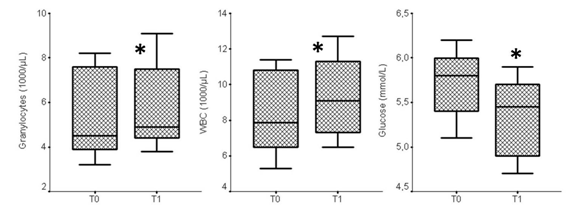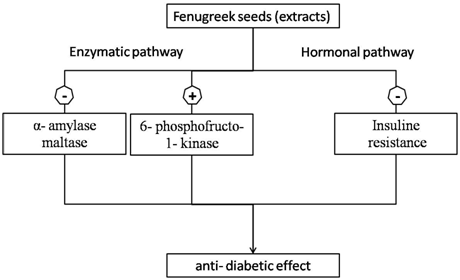eISSN: 2473-0815


Fenugreek (Trigonella foenumm- graecum L.) is widely used against several diseases. It owned great interest because it contains numerous biologically active substances. In this work, the in vivo effect of fenugreek seeds’ intake on hemodynamic, blood sugar level and hematological parameters was evaluated in healthy volunteers. Ten healthy volunteer men were included in the experiment. Their overnight fasting blood sugar level, hemodynamic and hematological parameters were measured before, and one hour after the intake of 10 g of powdered fenugreek seeds in a water suspension. The T-paired test showed significant decrease in the arterial blood pressure (from 9,2 ± 0,65 to 8,43 ± 0,31cmHg for the mean arterial pressure; and 7,8 ± 1,03 to 6,7 ± 0,67cmHgfor the arterial diastolic pressure) and heart frequency (from 77,3 ± 3,23 to 75,40 ± 3,37 bits/min), and an increase in total white blood cell (8,24 ± 2,29and 9,16± 2,20.103/µL; p ≤0,01) and granulocytes (5,26± 1,94 to 5,70 ± 1,86 .103/µL, p ≤0,01) counts, one hour after fenugreek seeds intake. In addition the overnight- fasting blood sugar level was diminished from 5,71 ± 0,37 to 5,37± 0,44 mmol/L, at p ≤ 0,001.The present work demonstrates the potential anti-hypertensive and anti-hyperglycemic effects of fenugreek seeds, and may support its use as alternate remedy against these chronic pathologies but cautions its application before conducting specific allergic tests .
Keywords: fenugreek, seeds, anti-hyperglycemia, anti-hypertension
Recently, great interest is brought back to therapeutic plants’ usage as nutritional supplement or medication for to manage and prevent several chronic diseases. Current researches highlighted that fenugreek (Trigonellafoenum- graecum L.), a Mediterranean annual Fabaceae herb, exerts beneficial effects on human and animal health. It is suggested to counteract obesity, cancer, diabetes, cardiovascular diseases, bacterial and fungal infestation, and reproductive tract problems, as well as much other pathology.1 The main phyto-therapeutic effects of T. foenum- graecum result from various bioactive compound it contains. Particularly, this plant is highly rich in proteins, amino acids, saponins, flavonoids, polyphenols, fibre, minerals and polysaccharides.2,3 The steroidal saponin, diosgenin, eugenol, gingenol, zingenone, cedrenefound in T. foenum- graecum seeds is owed great concern because of its anti-neoplastic activities.4–8 Other T. foenum- graecumfractions modulate blood sugar levels and insulin secretion and thereby ameliorate the woundhealing and prevent diabetes.9–12 The anti-obesity effect of fenugreek might be bypassed through repressing adipocytes’ proliferation and lipids metabolism.13,14 It also stimulates anti-oxidative enzymes activities and decreases the ROS release, a major protective pathway against several pathologies.15,16 In contrary, some case reports outlined that using fenugreek or its extract induced allergic reaction which was much pronounced in asthma patient.17
In this work, reprise thedescription of the effect of fenugreek intake on some clinic hematological parameters, in healthy volunteers.
Fenugreek preparation: a commercialized indigenous fenugreek (Trigonellafoenum-graecum L, Fabacae family) seeds were purchased from a local vendor. After washing using distillated water and dried into ambient temperature (20°C), 200 g of seeds were thinly powdered and mixed with drinking water in order to obtain a final solution’s volume of 2L.
Subjects: ten healthy men were admitted in the experiment. All patients did not have any pathological history, specifically diabetes and arterial hypertension. After being informed, they signed a written contentment for participation. Their anthropometric profile is shown in Table 1. Our experimental design was in conformity with the ethical guidelines of our country and was approved by a local ethical comity at the Laboratory of Pharmacology of the Medicine Faculty of Sfax.
Age (years) |
34,40 ± 3,23 |
Taille (m) |
1,71 ± 0,04 |
Poids (kg) |
76,64 ± 4,81 |
Table 1 Anthropometric parameters of the study-included volunteers
Study design
All subjects were kept fasting before and throughout the experimentation. Volunteers’ arterial blood pressure (systolic, diastolic and mean arterial pressures, and heart rate) and hematological (red blood cells (RBC), white blood cells (WBC), granuocytes and lymphocytes counts, hemoglobin concentration, mean corpuscular hemoglobin concentration (CCMH), mean corpuscular hemogloblin (TMH), mean globular volume (VGM), hematocrit (HCT), platelet count (PLT), Platelets distribution index (IDP) and mean platelets volume (VPM)) parameters, in addition to their blood sugar levels were diagnosed at admission and one hour after 100 ml of T. foenum- graecum solution’s intake. Before the consumption the solution was vigorously shaked. All diagnostic measurements were carried out by a unawarephysicianat a local hospital.
The blood pressure (Systolic [SAP] and Diastolic [DAP] and mean arterial [MAP] pressures) and heart frequency were registered using arm cuff- stethoscope, at a setting position, after at least 15 minutes of rest. Thereafter, withdrawal of venous blood samples were carried out, in order to assess hematological parameters (Mindray BC-3000 plusautomated apparatus, Shenzhen Mindray Bio-medical Electronics Co., Ltd.) and glucose level (Mindray BA-88A automated apparatus, Shenzhen Mindray Bio-medical Electronics Co., Ltd.), at each time- point of the experimentation.
Throughout and 2 hours after the experiment, subjects did not experience any sign of intoxication (nausea, vomiting and discomfort) and felt well.
Statistical analysis
T-test for depended variables was used to compare the obtained results between the baseline and 60 minutes after the T. foenum- graecum solution’s intake. SPSS for Windows. 11 software was used to carry out the statistical analysis. All the obtained results are expressed as mean values ± standard deviation.
a significant decrease of about 1 cm mmHg in the mean arterial blood pressure, 60 minutes after the treatment was noted. Since the systolic pressure remained constant, the observed PAM lowering is attributed to either? The diastolic phase and heart frequency that significantly diminished following the solution intake (p≤ 0,01; for both) (Figure 1). Similarly, the Fenugreek- postprandial level of blood sugar diminished significantly from 5,71 mmol/L to 5,37 mmol/L, at p ≤ 0,001 (Figure 2).

Figure 1 Variation of the arterial pressure and the cardiac frequency following T. foenum-graecum intake. (*) significant difference at p ≤ 0,01.

Figure 2 Variation of the granulocytes and white blood cells (WBC) counts and blood glucose level following T. foenum-graecum intake. (*) significant difference at p ≤ 0,01.
The analysis of the hematological profile did not exhibit any significant modification in erythrocytes and thrombocytes numerations and indices, except for the mean thrombocytes’ volume (VMP). This later decreased from 8,85 fL to 8,54 fL at the end of the experiment (p ≤ 0,01) (Table 2), (Table 3). The Figure 2 & Figure 3 shows a significant increase in granulocytes number (from 5,26 103/µL at T0 to 5,70 103/µL at T1, p ≤0,01); that modifies the total count of white blood cells (8,24 103/µL and 9,16 103/µL; respectively before and 60 minutes after fenugreek intake; p ≤ 0,001). Other immune cell parameters were unchanged (Table 4).

Figure 3 schematic potential mechanism of the anti-diabetic effect of fenugreek seeds (T. foenum- graecum L.).
Two pathways are proposed to explain the anti-hyperglycemic effects of fenugreek seeds: the first is bypassed through glucose metabolic enzymes, and involves the repression of amylase and maltase activities, and the enhancement of which of 6-phosphofructo-1-kinase. The second pathway includes the stimulation of insulin secretion and binding to its receptor, and thereby decreases the insulin resistance.
Time |
RBC (106/µL) |
HGB (g/dL) |
HCT (%) |
CCMH (g/dL) |
TMH (pg) |
VGM (fL) |
T0 (at admission) |
4,97±0,37 |
15,69±2,15 |
48,20±7,07 |
32,44±3,27 |
30,70±2,26 |
89,19±14,10 |
T1 (1hr after treatment) |
5,06±0,34 |
15,76±1,75 |
48,05±5,60 |
32,31±3,03 |
30,55±1,81 |
88,67±12,93 |
Table 2 Erythrocytes numeration and associated indices before and following T. foenum-graecum intake
Time |
PCT (%) |
IDP |
MPV (fL) |
T0 (at admission) |
0,237±0,023 |
15,67±0,18 |
8,85±0,62 |
T1 (1hr after treatment) |
0,228±0,024 |
15,54±0,23 |
8,54±0,51 (*) |
Table 3 Thrombocytes numeration and associated indices before and following T. foenum-graecum intake (*) significant difference at p ≤ 0,01
Time |
Lymphocytes (103/µL) |
Lymphocytes (%) |
Granulocytes (%) |
T0 (at admission) |
2,30±0,39 |
32,08±4,00 |
61,79±6,00 |
T1 (1hr after treatment) |
2,40±0,41 |
30,35±4,70 |
65,04±9,31 |
Table 4 White blood cells numeration and associated indices before and following T. foenum-graecum intake
Trigonellafoenum-graecum L has been used as a spice and medication against various diseases in folkloric medicine. Recently, great attention has been payed to its use, particularly for its anti-diabetic and anti tumor effects. In this work, some clinical hematological and hemodynamic outcomes are investigated in healthy volunteers following a water- suspension of powdered fenugreek, a traditional drink consumed by local Tunisian populations.
At the assayed dose (10 g of fenugreek seeds/ subject), there was a significant decrease in the mean arterial blood pressure which is attributed to the lowering of the diastolic event. Although several studies reported the use of this Fabacae plant as antihypertensive,18 few experimental works were reported, in such concern. Talpur et al.,20 found that a combination of various essential plants (olive, pumpkin, oregano, cinnamon, cumin, myrtle, fennel or ginger) oils, including which of T. foenum- graecum, exerts continual lowering of the arterial blood pressure, in fatty rats.19 The blood pressure decrease might result from the inhibitory effect of T. foenum- graecum L on the adrenergic and angiotensinergic vascular contractility.20 It was also shown that T. foenum- graecum’sseed extracts limit the angiotensin I conversion to its vasoconstrictor form (angiotensin II) by conformational docking to ACE site of action and its dislocation,4 thus reduces the systemic blood pressure.
As expected, substantial hypoglycemia was notedafter fenugreek seeds intake. The modulation of carbohydrate metabolic key enzymes, such as the repression of α-amylase and maltase activities and the enhancement of which of the phosphor-fructo-kinase in intestine mucosa and liver are the main modus operandi of the anti-hyperglycemic effect. In addition, it was evidenced that fenugreek (extracts) stimulates insulin secretion and/or activity and its receptor expression, and thereby improves diabetes mellitus wound healing.10,12,21
In our experimental series, granulocytes and total white blood cell counts were augmented. This event might explain Patil et al.,18 reported allergic reaction following fenugreek usage, in some clinical cases.17 Galactomannan, a polysaccharide found in T. foenum- graecum extracts, was shown to enhance the dentretic cells maturations.22 It also stimulates phagocytosis and macrophages proliferation.23,24 Some cell immune subsets mobilization / proliferationhave been also observed in 12- weeks treated Humans using a fenugreek extract (FurosapTM).25 This event might bring substantial explanation for the observed mobilization of immune cell lineages in our work.
Other authors reported that it exerts anti-inflammatory and anti-nociceptive action.25,26 Such divergence could be a consequence of the variability of the used part and extracts of the plant, and perhaps the dose and duration of administration.
In exception of the mean platelets’ volume decrease, we did not find significant changes in erythrocytes and thrombocytes parameters one hour after fenugreek intake. The decline in thrombocytes volume might be related to anti-aggregative effect of the plant.27 In long term? How long? Treatment usingthe phyto-therapeutic plant several reports outlined that it ameliorates hemoglobin synthesis and counteract anemia. Its richness in several metabolites and cofactors for hemoglobin synthesis such as iron, folate and ascorbate is sought as patent effectors against the pathology.26,28,29
Fenugreek seeds showed great potential to help the wound healing of several diabetes. In raison of its hypoglaecymic and anti- hypertensive effects, Trigonella foenum graecum consumption is suggested to remediate complicated diabetes. Because of the immune system activation by its extracts, particular measurement should be considered for allergic patients. Much deeper investigations are envisaged to better evaluate its usage as remedy for complicated diseases.
Authors acknowledge all the nursery staff of the Hospital of Ouled Haffouz (Sidi Bouzid- Tunisia) for their valuable collaboration.
This research did not receive any specific grant from funding agencies in the public, commercial, or not-for-profit sectors.

© . This is an open access article distributed under the terms of the, which permits unrestricted use, distribution, and build upon your work non-commercially.